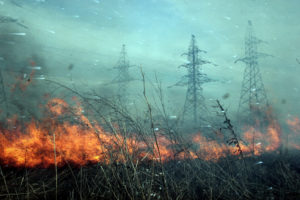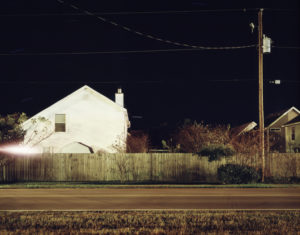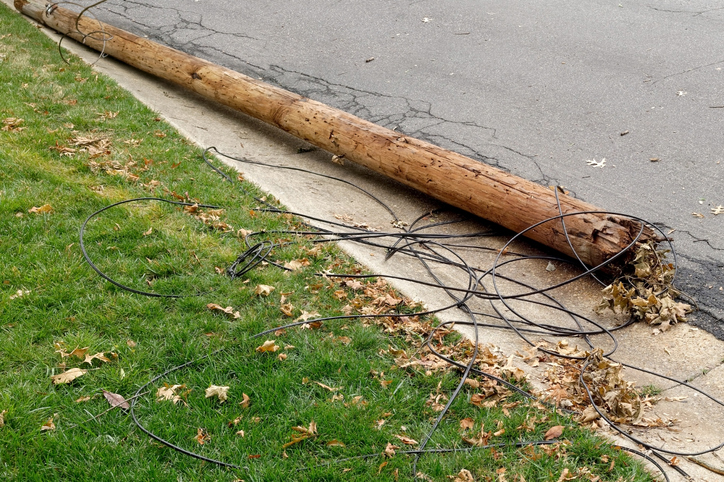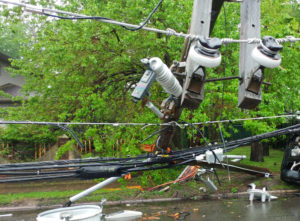Power Line Lawsuit
We see them everywhere. Along the highway, along city streets, anywhere people live. But we rarely stop to think about overhead power transmission lines, until something happens.
In you have been injured by electric shock or burn from a power line, or in a fire started by a power line, you may be entitled to compensation after filing a power line injury lawsuit. Contact our electrical burn injury and fire lawyers today for a free consultation. You never owe us anything at all unless we collect compensation for you.
Phone: 888-377-8900 | Text: 612-261-0856 | Email: [email protected] | Contact Us Online
There are nearly six million miles of overhead power lines in the United States. These lines commonly carry between 70,000 and 800,000 volts of electricity. That’s hundreds to thousands of times more than what it takes to operate a normal toaster. Electricity travels along the path of least resistance, and when a power line is safely intact, electricity will only travel along the wire. But unlike underground power lines, overhead power lines are not insulated. Because there is minimal protective coating, electricity can jump from an overhead power line to a person or object, if they provide a shorter path to ground. If that happens, the consequences can be devastating.
Injuries from Power Line Electrocution
Any amount of electricity in the body can cause harm. At low levels, like from a battery, electricity causes little more than a tingling discomfort. But even moderate amounts of electricity can cause painful and often permanent thermal burns, or even cause a person’s heart to stop beating correctly. 60% of people seen for electrical injuries also have one or more complications in addition to burns including sepsis, lung and heart injuries, brain injury, and cataracts among others.
Electrical Burn Injuries
Electrical burns are almost always present when an electrical accident occurs. Electrical burns from power lines can severely and permanently damage the bodies of victims and can devastate the lives of survivors. The American Burn Association estimates that electrical burn patients typically sustain 14% total body surface injuries on average and when power lines are involved the surface area affected by burns can be much greater than that. When electrical current actually enters the human body, electricity travels through your tissues seeking to reach either the ground or a path further down the electrical wire. But the human body isn’t a good conductor of electricity. Organs and tissues are obstacles to electricity’s path. In its mad search for an exit, electricity burns its way through the body, causing permanent and sometimes fatal muscle, nerve, brain, eye and other organ damages.
As it interacts with tissues, electric shock interferes with certain functions, including muscle function. At relatively moderate amperage (i.e., volume of electricity), muscle function is impaired, preventing the victim from “letting go” and gluing them to the source of deadly current. The inability to let go or break free exacerbates the injury by prolonging exposure.
Heart Damage and Heart Attacks
When electrical current travels through the chest cavity, current travels along nerves and blood vessels — which conduct electricity better than skin, bones, and fat —to the heart, causing permanent arrhythmias, and other cardiovascular injuries. Respiratory or cardiac arrest (heart attack) can occur with exposure to less than one amp. Injuries to the heart and lungs which may not be immediately deadly may require 24 hours or more of cardiac monitoring because delayed heart issues are not uncommon.
Brain Damage
Electric shock is also known to cause brain damage and other neurological complications. Electric shock can cause a loss of consciousness, resulting in secondary injury from blunt force trauma. Electricity can also cause the brain to become starved of oxygen leading to brain damage. Electric shock victims can suffer fatigue, pain, weakness, numbness, headaches, memory loss, mental impairment, dizziness, personality changes, and other neurologic and neuropsychological symptoms. For a quarter or more of victims, these symptoms can be long-lasting or permanent. The horrifying experience of sustaining a burn injury and the painful recovery journey a person goes through afterward can often lead to psychological trauma, depression and PTSD.
Amputation
More than any other type of burn injury, electrical burn injuries have the highest rate of amputation. In some cases, the hands, feet, arms, and legs are so badly burned that circulation cannot be restored. Amputation becomes necessary in these cases to save lives. Research in the International Journal of Physical Medicine & Rehabilitation shows that the most common amputations from burn injuries are to the fingers and toes, but the loss of arms and legs can also result from deep burns. Most electrical burn survivors who experienced an amputation go through extensive occupational and physical therapy to regain the ability to do activities of daily living, such as eating, dressing, and going to the bathroom.
Wrongful Death
Unfortunately, with the types of horrific injuries power transmission lines can cause people can easily succumb to the tissue and organ damage that results. Electricity’s effects on the heart also, all too often lead to fatal results. If a loved one dies for an injury caused by an overhead transmission line, family members may be able to sue in order to collect compensation and to seek justice for their loved one.
Compensation
If a person is injured or killed by contact with a power line, they or their family can contact our burn injury and electrical shock lawyers for a free consultation to determine if they can file a lawsuit against the power company that was responsible for safely maintaining the power lines that lead to their injury.
Lawsuit for a Fire Caused by a Power Line
Downed power lines don’t just cause electrical burns. Electricity can also light a victim’s clothing on fire or start a building on fire, causing severe and potentially fatal thermal burns and suffocation. Fires started outdoors by electrical power lines can even set whole forests on fire and lead to massive damage and many injuries.
Forest Fires Caused by Electric Utility Negligence

If a person is injured or killed by a fire caused by the negligent installation or maintenance of power lines or faulty components used in power line equipment, they and their family may have a legal claim. These types of cases are complex and our power line fire and burn lawyers can answer your legal questions about your particular legal case.
How do Power Line Accidents Occur?
Power Line Injuries at Work
Any contact – or near contact since electricity can “arc” or jump across short distances – can cause an electrical burn or shock accident. Some of the most common electrical injuries are work related. Construction workers and contractors working on structures near utility lines may accidentally contact overhead power lines with their ladders, backhoes, or other equipment. According to the American Burn Association, electrical burns are the 4th leading cause of traumatic work-related deaths.
Home and Bystander Power Line Injuries
But anyone can be injured in an electrical accident. A homeowner who places a ladder too close to a line carrying electricity can be electrocuted. A person unknowingly standing too close to a downed power line can be burned and electrocuted even some distance away as the electricity travels through the ground. There have even been reports of children being electrocuted while pitching a tent under a power line; tent poles that get too close to a power line can transfer dangerous amounts of electricity to the ground and then electrocute people even some distance away.
Defective or Poorly Maintained Utility Poles
Overhead power lines can pose a hidden danger as well. Utility poles and towers can have hidden structural defects caused by poor design or maintenance. If those flaws are left unattended, a utility pole or tower could collapse, causing active power lines to fall.
Wooden utility poles are often 50 or 60 years old, sometimes older. Over decades, these wooden poles can be exposed to rot and degradation. Moisture, salt, and other road treatments can damage the buried part of a utility pole, while woodpeckers, termites, and other animals can degrade the wood above ground. A decayed pole can be blown over in the wind or collapse under its own weight. Poorly maintained or constructed metal utility poles can also pose a hazard. A metal utility tower with shoddy rivets, inferior metal alloys, or other structural problems can cause rust, buckling, and collapse over time or during severe weather events.
Even where a utility pole itself has been properly constructed and maintained, outside influences can affect its structural integrity. Tree branches that are allowed to grow too close to power lines can break in a storm and tear down those lines.
Utility Poles Damaged by Car Accidents
Power lines can also fall as a result of a car accident. Modern utility poles are designed to break away from their base upon impact, so as to minimize the damage to the impacting vehicle. The occupants of a vehicle involved in a utility pole collision will usually be safe from electric shock inside their vehicle. If they leave their vehicle or if any bystanders are close, they may be exposed to a serious hazard.
Power lines themselves are not the only equipment that can fail and cause injury. Insulators, switches, and other components may fail cause electrical hazards and fire and faulty transformers can explode dramatically. These explosions spray burning shrapnel and can fuel electrical fires that are difficult to control.
Who is Responsible for Keeping Overhead Power Transmission Lines Safe?
While many utilities may share the use a single pole (telephone, cable, fiber optics, and electricity, for example), the pole itself may be owned by one or two entities. Usually, the pole owner has some responsibility to maintain it in safe condition. Pole tags — if they haven’t fallen off — will identify the pole owner.
Electric Power Companies Must Insure Power Lines Are Safe
Whoever owns the pole, electric companies have an obligation to ensure their equipment doesn’t pose a needless public danger. The National Electric Safety Code outlines when an electric company must inspect and maintain its power lines. State and local laws might complement national codes. But too often, these laws allow utility companies to go years without checking the integrity of overhead power lines and equipment.
Fortunately, courts have filled in the gap, requiring “reasonably frequent” inspections under the circumstances. If a power company had reason to know about a risk or defect, but took no action, the company may be found liable for violating its obligations to the public and may be required to compensate victims for the consequences of the company’s inaction.
While “smart” technologies would allow power companies to monitor their systems remotely, utility companies too often rely on bystander reporting. But by the time a bystander witnesses a power line failure and reports it, it may be too late to prevent a catastrophe.
Safer yet would be underground power lines that eliminate many of the vulnerabilities inherent in our overhead power grids. But relocating power lines is expensive, and cuts into corporate profits. So power companies have been reluctant to adopt safer systems.
Filing a Power Line Lawsuit
What to do if you or a loved one is injured or killed by a power line
If you’ve been injured as a result of any kind of power line failure, or if a family member was killed by a power transmission line accident or fire, you need the help of an experienced fire and electrocution lawyer. Our attorneys have decades of experience holding utility companies and others accountable for injuries like yours and can help you obtain the compensation you deserve. Contact us today at 1-888-377-8900 or use the form below –


